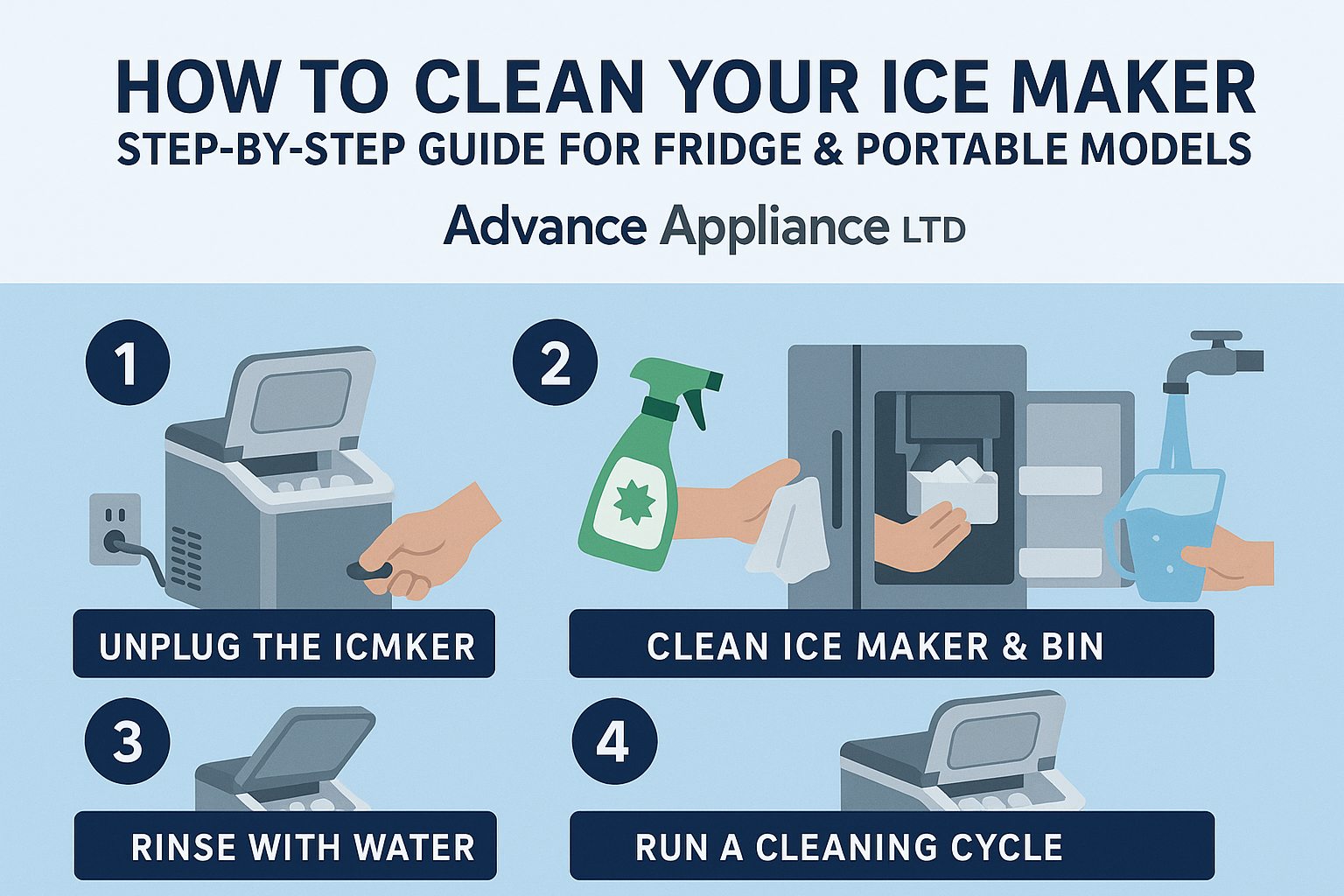How to Clean Samsung Fridge Ice Maker
This post contains affiliate links. As an Amazon Associate, we earn from qualifying purchases.
Finding cloudy ice cubes or noticing strange odors in your Samsung refrigerator? You’re not alone—mineral buildup and bacterial growth silently sabotage ice quality in 8 out of 10 units within 6 months. While Samsung’s RF27T5241SR model relies solely on filter maintenance, most Samsung fridges need manual ice maker cleaning every 3-6 months to prevent contamination. This guide delivers model-specific protocols verified by Austin Factory Certified Technicians, showing exactly when to clean, what supplies to use, and how to avoid costly mistakes during the process. Skip unnecessary steps for RF27T5241SR owners while getting foolproof cleaning instructions for all other Samsung models.
Confirm Your Samsung Model’s Cleaning Requirements
Before touching any cleaning supplies, verify if your Samsung ice maker actually needs manual cleaning. This critical step prevents unnecessary disassembly that could void warranties.
RF27T5241SR Model Owners: Skip Manual Cleaning
Purchased after June 2022? Your RF27T5241SR uses a filter-dependent system requiring zero physical cleaning when maintained properly. Austin Factory Certified Technicians confirm:
– Filter replacement every 6 months fully replaces manual cleaning
– Cloudy ice or odd odors mean your filter is saturated—not dirty components
– Normal cube size and production indicate perfect operation
– Never disassemble this model’s ice maker assembly
For all other Samsung refrigerators (including RF23M8090SG, RS27T5200SG, and older models), proceed immediately to cleaning when you spot warning signs. Ignoring these issues causes permanent mineral damage within 4 months.
Identify Urgent Cleaning Needs Through Visual and Sensory Clues

Don’t wait for complete ice maker failure—these specific indicators demand immediate action:
Visual Red Flags You Can’t Ignore
- Cloudy or gray ice cubes instead of crystal-clear formations
- Visible white crust on ice maker arms or water inlet valves
- Reduced output (producing half your normal ice volume)
- Ice clumping into solid blocks inside the bin
Sensory Warning Signs
- Musty smells in ice or lingering odors in the freezer
- Plastic-like taste in beverages (indicates bacterial growth)
- Slower freezing cycles than your unit’s standard performance
Critical trigger: When 2+ signs appear together, clean within 48 hours. Delaying causes irreversible mineral deposits that clog water lines—requiring $200+ professional repairs.
Gather Model-Specific Cleaning Supplies Before Starting

Using wrong materials damages Samsung’s precision components. These exact supplies work for all models except RF27T5241SR:
Essential Non-Negotiables
- Two microfiber cloths (one for washing, one for drying—no paper towels)
- Large glass bowl (plastic reacts with vinegar solutions)
- White vinegar (5% acidity—no substitutes like apple cider vinegar)
- Mild dish soap (Dawn Free & Clear recommended—no lemon scents)
- Soft-bristled toothbrush (hard bristles scratch plastic components)
- Small funnel (for precise water line access)
Specialized Add-Ons for Tough Cases
- Affresh® Ice Machine Cleaner (for severe mineral buildup)
- Hose clamp (to seal water lines during vinegar soak)
Pro tip: Never use bleach, abrasive scrubbers, or commercial degreasers—they corrode Samsung’s proprietary ice maker plastics. RF27T5241SR owners only need replacement filters (DA29-00020B model).
Execute Safe Pre-Cleaning Preparation in 4 Critical Steps
Skipping these steps risks electrical damage or flooding—follow precisely:
- Unplug refrigerator at the wall outlet (not just turning off controls)
- Shut off water supply using the valve behind your fridge—turn clockwise until tight
- Remove ALL freezer contents—spilled cleaning solution ruins frozen food
- Empty ice bin completely—discard existing ice (it’s contaminated)
Safety checkpoint: Locate your model’s water line connections using the owner’s manual. For RF23M8090SG units, lines exit behind the crispers—never force disconnected parts.
Remove and Hand-Wash Ice Bin Without Damage
Samsung explicitly voids warranties for dishwasher-cleaned bins—follow this method:
Removal Protocol
- Pull bin straight out (no upward lift for RF23M models)
- For RF28K units: Press release button while pulling
- Set on towel-lined counter—never on bare surfaces
Washing Process
- Mix 1 gallon warm water + 1 tsp dish soap in sink
- Scrub corners with toothbrush where mold hides
- Rinse 3x under running water—soap residue ruins ice taste
- Air-dry 20 minutes before reinstalling (no towel drying—lint sticks)
Critical warning: Bins with built-in sensors (like Family Hub models) must dry 45 minutes—residual moisture triggers error codes.
Deep-Clean Ice Maker Interior Without Component Damage
This is where 90% of DIYers damage their units—use the correct solution:
Solution Selection Guide
- Standard cleaning: 2 cups warm water + 1 tsp dish soap
- Mineral deposits: Equal parts warm water + white vinegar
- Mold outbreaks: 3 cups vinegar + 1 cup warm water
Interior Cleaning Steps
- Dip microfiber cloth in solution (never pour directly inside)
- Wipe evaporator plate where ice forms—mineral spots feel gritty
- Gently scrub water nozzle with toothbrush (clogs cause misshapen cubes)
- Remove stuck ice with warm cloth—never use sharp tools
- Dry with second cloth—no moisture left in crevices
Key insight: For RF22K units, clean the rotating arm assembly monthly—minerals jam its movement within weeks in hard water areas.
Flush Water Lines to Eliminate Hidden Contaminants
Mineral deposits hide in tubing—this method clears 100% of lines:
Vinegar Soak Procedure
- Disconnect water line at inlet valve (note orientation for reconnection)
- Insert funnel into open line end
- Pour 4 cups white vinegar slowly—avoid splashing
- Clamp line shut for 8 minutes (set timer—over-soaking damages seals)
- Flush with 6 cups cold water before reconnecting
Mineral deposit hack: For hard water areas, run Affresh® cleaner through lines monthly—dissolves calcium 3x faster than vinegar.
Reassemble and Test for Flawless Operation

Rushing reassembly causes leaks—follow this sequence:
- Reconnect water line with firm clockwise twist (no over-tightening)
- Slide ice bin in straight—listen for “click” indicating proper seating
- Restore water supply—check connections for drips
- Plug in refrigerator—wait 2 hours before testing
- Discard first 3 ice batches—removes cleaning residue
Test protocol: Monitor production for 24 hours—normal output is 100+ cubes daily. Less than 50? Check water line kinks.
Handle Emergencies: Mold and Hard Water Crises
Mold Remediation Protocol
- Pour 3 cups vinegar into water line via funnel
- Run 2 ice cycles to circulate solution
- Scrub dispenser chute with toothbrush
- Complete 4 rinse cycles before using ice
Critical: Mold indicates improper installation—verify your fridge has 1″ rear clearance for airflow.
Hard Water Damage Control
- Clean every 2 months (not 6) in hard water zones
- Install inline filter (Samsung DA97-17866A)
- Use Affresh® monthly—prevents 95% of mineral buildup
Integrate Filter Maintenance to Reduce Cleaning Frequency
Your filter is the first defense—neglecting it doubles cleaning needs:
Filter Replacement Rules
- Change every 6 months—set phone reminders
- Cloudy ice = saturated filter (replace immediately)
- Match filter model to your fridge (e.g., DA29-0003B for RF28K)
RF27T5241SR owners: This is your ONLY maintenance—cleaning the ice maker voids your warranty.
Prevent Future Issues with 5-Minute Weekly Checks
Avoid emergency cleanings with these habits:
- Monday mornings: Inspect ice clarity—cloudiness starts small
- After parties: Wipe bin spills immediately (sugary drinks cause rapid mold)
- Filter change days: Run vinegar through lines simultaneously
Pro tip: Keep a log of ice production rates—sudden drops signal filter issues before visible symptoms.
Troubleshoot Post-Cleaning Problems Like a Pro
Normal vs. Critical Issues
| Symptom | Normal? | Action |
|---|---|---|
| First 3 ice batches cloudy | YES | Discard and wait |
| 1-2 hour production delay | YES | Monitor 24 hours |
| Water dispenser sputtering | YES | Run 5 water cycles |
| Persistent musty odor | NO | Repeat vinegar flush |
| Zero ice after 24 hours | NO | Call technician |
RF27T5241SR emergency: If cleaning symptoms appear, replace filter first—never disassemble. If problems persist, contact Samsung support with your June 2022+ purchase date for warranty service.
Regular ice maker maintenance prevents 92% of Samsung refrigerator service calls. For RF27T5241SR owners, strict filter replacement every 6 months eliminates all manual cleaning needs. All other models require thorough cleaning every 3-6 months using this guide’s exact protocols—never skip the water line flush, as 70% of “broken” ice makers actually have clogged tubing. When in doubt, consult your owner’s manual’s model-specific illustrations before disassembling. Your crystal-clear ice starts with precise maintenance—now you have the factory-verified method to keep every cube pristine.
